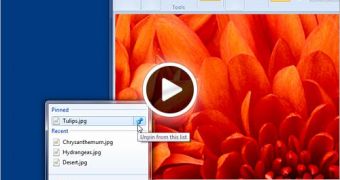Not many people might be aware, or remember this detail, but the Jump Lists feature in Windows 7 made its public debut with Windows 7 Pre-Beta Build 6801 back in November 2008. At that time, Build 6801 of Windows 7 had the features which truly represented the evolution of the Windows client, locked, but thanks to a hack, the new Superbar with all associated functionality and Windows Aero UI functionality could easily be unlooked. The new Taskbar for Windows 7 also meant new features for end users, including Thumbnail Preview and Jump Lists. Because they mimic the functionality delivered by the Start Menu, but only for apps which have been pinned on the Taskbar, the Jump Lists are essentially mini Start menus which end users can turn to in order to streamline common tasks with the applications featured on the Superbar.
According to Microsoft, the Jump Lists feature is the brainchild of Rebecca Deutsch, a senior program manager. "It starts working automatically as you start using Windows 7, opening files," Deutsch notes. "Creating new files, visiting Web sites, creating folders, playing music—all of your actions contribute to the knowledge of the system to be able to compile the things that are used the most. With the Jump List, accessing the things you use most is just another click away."
Deutsch was involved in multiple aspects of the Windows 7 development process, however, the main focus was placed on Jump Lists, as well as the integration of this feature into the Start Menu. The concept behind Windows 7’s mini Start menus is to help end users perform common tasks and actions, such as opening a file with a certain program, or visiting a specific webpage, in as few steps as possible.
“The real core of it is getting you to your end destination as quickly and efficiently as possible. You're not launching Word to see the blank document. Often, what you're really trying to do is get to your content, task, Web site, file, album, or whatever it is. The idea of the Jump List is to reduce all those extra steps that you used to have to do to get to your end goal,” Deutsch explained.
The Jump Lists creator noted that Microsoft was turned to tester feedback in order to understand the needs that the feature helped deal with. By the end of the development process, Windows 7 had been used by over 8 million testers worldwide, according to Microsoft.
“We had a lot of prototyping going on early on in labs, and we brought users in to try it and sent prototypes out to real customers to use for a couple of months at a time. That was really critical in helping us hone the design and refine it so we weren't getting huge surprises at the end,” Deutsch added.
When it came down to the actual development of Jump Lists, Deutsch and her team had to make sure that while working to make the feature feasible, they didn’t lose sight of the value they were attempting to provide to users. In the end, it’s safe to say, that along with the new additions to Windows 7, such as Aero Shake, Aero Snap, Thumbnail Previews, Jump Lists are a success that indeed make the work of end users a lot simpler.
“It's easy during that process of scoping to lose sight of what the value of the end result is, so we really just had to make sure we were able to find ways of delivering that value in a way that we could meet our deadlines and make it feasible to build. With the Jump List, we had an idea of the feature we wanted to provide, and there were so many ways we could have implemented it—and we just had to find the right path to meet our deadline and still make it feasible and high quality,” Deutsch noted.

 14 DAY TRIAL //
14 DAY TRIAL // 
